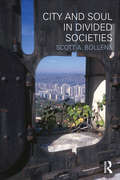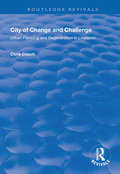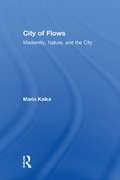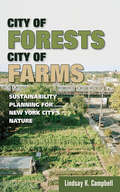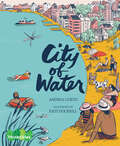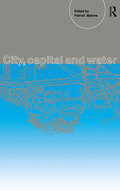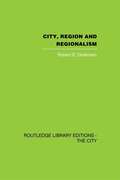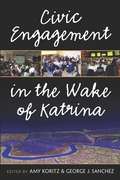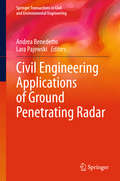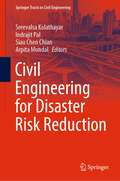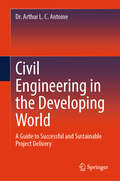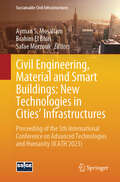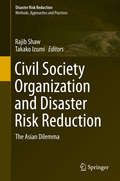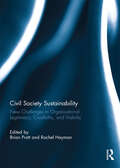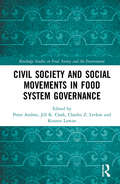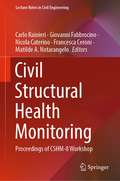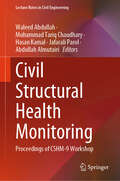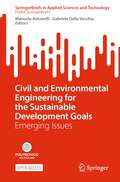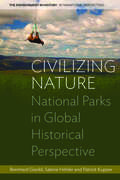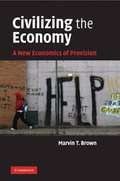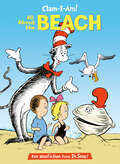- Table View
- List View
City and Soul in Divided Societies (Planning, History and Environment Series)
by Scott A. BollensIn this unique book Scott A. Bollens combines personal narrative with academic analysis in telling the story of inflammatory nationalistic and ethnic conflict in nine cities – Jerusalem, Beirut, Belfast, Johannesburg, Nicosia, Sarajevo, Mostar, Bilbao, and Barcelona. Reporting on seventeen years of research and over 240 interviews with political leaders, planners, architects, community representatives, and academics, he blends personal reflections, reportage from a wealth of original interviews, and the presentation of hard data in a multidimensional and interdisciplinary exploration of these urban environments of damage, trauma, healing, and repair. City and Soul in Divided Societies reveals what it is like living and working in these cities, going inside the head of the researcher. This approach extends the reader’s understanding of these places and connects more intimately with the lived urban experience. Bollens observes that a city disabled by nationalistic strife looks like a callous landscape of securitized space, divisions and wounds, frozen in time and in place. Yet, the soul in these cities perseveres. Written for general readers and academic specialists alike, City and Soul in Divided Societies integrates facts, opinions, photographs, and observations in original ways in order to illuminate the substantial challenges of living in, and governing, polarized and unsettled cities.
City of Change and Challenge: Urban Planning and Regeneration in Liverpool (Routledge Revivals Ser.)
by Chris CouchThis title was first published in 2003. Over the last 30 years, Liverpool has undergone more economic restructuring and urban change than virtually any other city in Britain and Europe. It has also been a testing ground for almost every experiment and innovation in modern urban policy. City of Change and Challenge analyses the urban planning and regeneration experience in Liverpool over this period. In doing so, it considers the extent to which the pressure to create jobs has led to economic development aims consistently taking precedence over environmental and social concerns, and the degree to which regeneration has been dominated by centralised and top-down approaches without a strong strategic planning framework. It also discusses why some policies and programmes have been more successful than others and what lessons might be learned, not only by Liverpool's future policy makers, but also by planners, politicians and academics throughout the world.
City of Flows: Modernity, Nature, and the City
by Maria KaikaTypically, cities and nature are perceived as geographic opposites, cities being manufactured social creations, and nature being outside of human construction. Through a historical geography of water in the modern city, Kaika shows that this is not the case. Rather, nature and the modern city are fully intertwined, with cities integrating nature at
City of Forests, City of Farms: Sustainability Planning for New York City’s Nature
by Lindsay K. CampbellCity of Forests, City of Farms is a history of recent urban forestry and agriculture policy and programs in New York City. Centered on the 2007 initiative PlaNYC, this account tracks the development of policies that increased sustainability efforts in the city and dedicated more than $400 million dollars to trees via the MillionTreesNYC campaign. Lindsay K. Campbell uses PlaNYC to consider how and why nature is constructed in New York City. Campbell regards sustainability planning as a process that unfolds through the strategic interplay of actors, the deployment of different narrative frames, and the mobilizing and manipulation of the physical environment, which affects nonhuman animals and plants as well as the city's residents.Campbell zeroes in on a core omission in PlaNYC's original conception and funding: Despite NYC having a long tradition of community gardening, particularly since the fiscal crisis of the 1970s, the plan contained no mention of community gardens or urban farms. Campbell charts the change of course that resulted from burgeoning public interest in urban agriculture and local food systems. She shows how civic groups and elected officials crafted a series of visions and plans for local food systems that informed the 2011 update to PlaNYC. City of Forests, City of Farms is a valuable tool that allows us to understand and disentangle the political decisions, popular narratives, and physical practices that shape city greening in New York City and elsewhere.
City of Water (ThinkCities)
by Andrea CurtisThe second book in the ThinkCities series explores water as a precious, finite resource, tracing its journey from source, through the city, and back again. Living in cities where water flows effortlessly from our taps and fountains, it’s easy to take it for granted. City of Water, the second book in the ThinkCities series, shines a light on the water system that is vital for our health and well-being. The narrative traces the journey of water from the forests, mountains, lakes, rivers and wetlands that form the watershed, through pipes and treatment facilities, into our taps, fire hydrants and toilets, then out through storm and sewer systems toward wastewater treatment plants and back into the watershed. Along the way we discover that some of the earliest cities with water systems date back to the Indus Valley in 2500 BC; that in 1920 only 1 percent of the US population had indoor plumbing; that if groundwater is used up too quickly, the land can actually sink; and more. The text is sprinkled with fun and surprising facts — some water fountains in Paris offer sparkling water, and scientists are working to extract microscopic particles of precious metals found in sewage. Readers are encouraged to think about water as a finite resource, and to take action to prevent our cities and watersheds from becoming more polluted. More than 2 billion people in the world are without access to safe, fresh water at home. As the world’s population grows, along with pollution and climate change, access to clean water is becoming an urgent issue. Includes practical steps that kids can take to help conserve water. The ThinkCities series is inspired by the urgency for new approaches to city life as a result of climate change, population growth and increased density. It highlights the challenges and risks cities face, but also offers hope for building resilience, sustainability and quality of life as young people advocate for themselves and their communities. Correlates to the Common Core State Standards in English Language Arts: CCSS.ELA-LITERACY.RL.3.3 Describe the relationship between a series of historical events, scientific ideas or concepts, or steps in technical procedures in a text, using language that pertains to time, sequence, and cause/effect.
City, Capital and Water
by Patrick MaloneThe urban waterfront is widely regarded as a frontier of contemporary urban development, attracting both investment and publicity. City, Capital and Water provides a detailed account of the redevelopment of urban waterfronts in nine cities around the world: London, Tokyo, Kobe, Osaka, Hong Kong, Sydney, Toronto, Dublin and Amsterdam. The case studies cover different frameworks for development in terms of the role of planning, approaches to financing, partnership agreements, state sponsorship and development profits. The analysis also demonstrates the effects of economic globalization, deregulation, the marginalization of planning and the manipulation of development processes by property and political interests.
City, Region and Regionalism: A geographical contribution to human ecology
by Robert E. DickinsonThis book was first published in 1947.
Civic Engagement in the Wake of Katrina
by Amy Koritz George J. SanchezThis collection of essays documents the ways in which educational institutions and the arts community responded to the devastation wrought by Hurricane Katrina. While firmly rooted in concrete projects, Civic Engagement in the Wake of Katrina also addresses the larger issues raised by committed public scholarship. How can higher education institutions engage with their surrounding communities? What are the pros and cons of "asset-based" and "outreach" models of civic engagement? Is it appropriate for the private sector to play a direct role in promoting civic engagement? How does public scholarship impact traditional standards of academic evaluation? Throughout the volume, this diverse collection of essays paints a remarkably consistent and persuasive account of arts-based initiatives' ability to foster social and civic renewal.
Civil Engineering Applications of Ground Penetrating Radar (Springer Transactions in Civil and Environmental Engineering)
by Andrea Benedetto Lara PajewskiThis book, based on Transport and Urban Development COST Action TU1208, presents the most advanced applications of ground penetrating radar (GPR) in a civil engineering context, with documentation of instrumentation, methods and results. It explains clearly how GPR can be employed for the surveying of critical transport infrastructure, such as roads, pavements, bridges and tunnels and for the sensing and mapping of underground utilities and voids. Detailed attention is also devoted to use of GPR in the inspection of geological structures and of construction materials and structures, including reinforced concrete, steel reinforcing bars and pre/post-tensioned stressing ducts. Advanced methods for solution of electromagnetic scattering problems and new data processing techniques are also presented. Readers will come to appreciate that GPR is a safe, advanced, non destructive and noninvasive imaging technique that can be effectively used for the inspection of composite structures and the performance of diagnostics relevant to the entire life cycle of civil engineering works.
Civil Engineering for Disaster Risk Reduction (Springer Tracts in Civil Engineering)
by Indrajit Pal Sreevalsa Kolathayar Siau Chen Chian Arpita MondalThe book is a comprehensive volume on multi-hazards and their management for a sustainable built environment. It focuses on the role of civil engineering in building disaster resilient society. This book brings together all diverse disciplines of civil engineering and related areas (for example, geotechnical engineering, water resources engineering, structural engineering, transportation engineering, environmental engineering, construction management, GIS, and remote sensing) towards a common goal of disaster resilience through an interdisciplinary approach. It contains methods and case studies focusing on civil engineering solutions to reduce the disaster risk. The book contents are aligned in line with the priorities set by UN-Sendai Framework for Disaster Risk Reduction and UN-SDGs to promote a global culture of risk-awareness and disaster reduction. The book will be a useful comprehensive reference for disaster risk reduction beneficial for engineering students, teaching faculty, researchers, industry professionals and policymakers.
Civil Engineering in the Developing World: A Guide to Successful and Sustainable Project Delivery
by Dr. Arthur L. C. AntoineThis book provides a pragmatic roadmap for mastering project delivery in civil and infrastructure engineering—one that applies across both developing and industrialized nations. Dr. Arthur L.C. Antoine, an experienced civil engineer, project manager, and researcher, blends real-world case studies with empirical data to scrutinize current project delivery methods and performance. With a focus on the foundational pillars of schedule, cost, and quality—alongside the critical but often overlooked elements of procurement and risk—this book offers a fresh perspective for industry professionals, policymakers, and stakeholders. Through practical insights and rigorous analysis, Dr. Antoine challenges conventional approaches, highlights global best practices, and presents actionable recommendations for delivering infrastructure projects that are successfully delivered with a focus on long-term transformation. The book is ideal for engineers, project managers, public works leaders, and anyone invested in the future of infrastructure development.
Civil Engineering, Material and Smart Buildings: Proceeding of the 5th International Conference on Advanced Technologies and Humanity (ICATH'2023) (Sustainable Civil Infrastructures)
by Brahim El Bhiri Ayman S. Mosallam Safae MerzoukAs cities continue to grow and evolve, the challenges of building sustainable, resilient, and efficient urban environments have never been greater. This comprehensive volume presents cutting-edge research and innovative solutions in the fields of construction, materials science, and civil engineering. With contributions from leading experts and researchers, this book explores the transformative role of new technologies, sustainable materials, and advanced methodologies in shaping the future of cities worldwide. Part 1: New Ideas and Innovations in City Structures showcases groundbreaking research in areas such as manganese enrichment from mining tailings, the integration of machine learning in civil engineering, and the harmonious blend of mathematics and aesthetics in urban design through Moroccan and Andalusian tiling. These innovations push the boundaries of what’s possible in urban planning and construction, offering insights into the future of city development. Part 2: Construction and Materials delves into the practical applications and challenges of using sustainable materials like Ferrock concrete, recycled asphalt pavement, and fiber-reinforced polymers (FRP) for structural reinforcement. With a focus on durability and environmental impact, this section provides a thorough review of current best practices and emerging technologies that promise to revolutionize the construction industry. Part 3: Testing and Technologies in Urban Infrastructure highlights the latest testing techniques and technologies used to evaluate and improve the safety, efficiency, and sustainability of urban buildings and infrastructure. From seismic performance in reinforced concrete structures to the development of zero-energy buildings, this section offers a detailed analysis of the cutting-edge methods that are driving innovation in modern cityscapes. This book is an essential resource for professionals, researchers, and students in civil engineering, urban planning, and materials science. By exploring both theoretical concepts and real-world applications, " Civil Engineering, Material, and Smart Buildings: New Technologies in Cities' Infrastructures" provides valuable insights into the future of urban construction and the key technologies that will shape the cities of tomorrow.
Civil Society Organization and Disaster Risk Reduction: The Asian Dilemma (Disaster Risk Reduction)
by Rajib Shaw Takako IzumiCivil society organizations (CSOs) have played important roles over the years in the disaster field Starting from the traditional approach of response and relief, the emphasis has gradually shifted to disaster risk reduction From international nongovernmental organizations (NGOs) to national and local NGOs, all stakeholders have recognized the significance of and need for community-based risk reduction. In their different capacities they have endeavored to establish links to the policy options at the local and national levels There still are many issues that remain untouched by CSOs, however, and local CSOs face special challenges in resources in terms of human, financial, and technical issues Drawing examples from Asia, this book is structured on the roles of CSOs according to the Hyogo Framework for Action priority areas: policy making, risk assessment, education and training, underlying risk factors, and response-recovery The primary target groups for this book are students and researchers in the fields of environment, disaster risk reduction, and climate change studies The book provides a clear view of the current trends of research in the field and furnishes basic knowledge on these important topics Another target group comprises practitioners and policy makers, who will be able to apply the knowledge collected here to policy and decision making.
Civil Society Sustainability: New challenges in organisational legitimacy, credibility, and viability
by Brian Pratt and Rachel HaymanThis publication focuses on the challenges faced by civil society to remain sustainable in response to major changes in the global political, economic and social environment. Academics and practitioners from all over the world have contributed original articles, practical notes and viewpoints which critically examine the ways in which civil society organisations are affected by and are responding to political and financial dynamics. These include reductions in traditional external aid for civil society activities, but also the growth of new forms of funding through social enterprise, philanthropy, fundraising and contractual relationships with national government. The operating environment for civil society is a central theme, with authors exploring the legitimacy and credibility of different types of civil society organisation, as well as the effects of legislative and regulatory restrictions on their sustainability. The contributions finally examine new opportunities for civil society and the prospects for organisations to emerge that are less dependent on foreign aid funding, that are more embedded in local communities, and that can bring about lasting and sustained social and economic change. This book was originally published as a special issue of Development in Practice.
Civil Society and Social Movements in Food System Governance (Routledge Studies in Food, Society and the Environment)
by Charles Z. Levkoe Kristen Lowitt Peter Andrée Jill K. ClarkThis book offers insights into the governance of contemporary food systems and their ongoing transformation by social movements. As global food systems face multiple threats and challenges there is an opportunity for social movements and civil society to play a more active role in building social justice and ecological sustainability. Drawing on case studies from Canada, the United States, Europe and New Zealand, this edited collection showcases promising ways forward for civil society actors to engage in governance. The authors address topics including: the variety of forms that governance engagement takes from multi-stakeholderism to co-governance to polycentrism/self-governance; the values and power dynamics that underpin these different types of governance processes; effective approaches for achieving desired values and goals; and, the broader relationships and networks that may be activated to support change. By examining and comparing a variety of governance innovations, at a range of scales, the book offers insights for those considering contemporary food systems and their ongoing transformation. It is suitable for food studies students and researchers within geography, environmental studies, anthropology, policy studies, planning, health sciences and sociology, and will also be of interest to policy makers and civil society organisations with a focus on food systems.
Civil Structural Health Monitoring: Proceedings of CSHM-8 Workshop (Lecture Notes in Civil Engineering #156)
by Carlo Rainieri Giovanni Fabbrocino Nicola Caterino Francesca Ceroni Matilde A. NotarangeloThis volume gathers the latest advances and innovations in the field of structural health monitoring, as presented at the 8th Civil Structural Health Monitoring Workshop (CSHM-8), held on March 31–April 2, 2021. It discusses emerging challenges in civil SHM and more broadly in the fields of smart materials and intelligent systems for civil engineering applications. The contributions cover a diverse range of topics, including applications of SHM to civil structures and infrastructures, innovative sensing solutions for SHM, data-driven damage detection techniques, nonlinear systems and analysis techniques, influence of environmental and operational conditions, aging structures and infrastructures in hazardous environments, and SHM in earthquake prone regions. Selected by means of a rigorous peer-review process, they will spur novel research directions and foster future multidisciplinary collaborations.
Civil Structural Health Monitoring: Proceedings of CSHM-9 Workshop (Lecture Notes in Civil Engineering #516)
by Waleed Abdullah Muhammad Tariq Chaudhary Hasan Kamal Jafarali Parol Abdullah AlmutairiThis book gathers the latest advances and innovations in the field of structural health monitoring, as presented at the 9th Civil Structural Health Monitoring Workshop (CSHM-9), held in Kuwait on February 12–14, 2024. It discusses emerging challenges in civil SHM and more broadly in the fields of smart materials and intelligent systems for civil engineering applications. The contributions cover a diverse range of topics, including applications of SHM to civil structures and infrastructures, innovative sensing solutions for SHM, data-driven damage detection techniques, nonlinear systems and analysis techniques, influence of environmental and operational conditions, aging structures and infrastructures in hazardous environments, and SHM in earthquake prone regions. Selected by means of a rigorous peer-review process, they will spur novel research directions and foster future multidisciplinary collaborations.
Civil and Environmental Engineering for the Sustainable Development Goals: Emerging Issues (SpringerBriefs in Applied Sciences and Technology)
by Manuela Antonelli Gabriele Della VecchiaThis open access volume collects emerging issues in Environmental and Civil Engineering, originating from outstanding doctoral dissertations discussed at Politecnico di Milano in 2021. The advanced innovative insights provided are presented with reference to the relevant sustainable development goals (SDGs), hoping that scientists, technicians and decision makers will find them as a valid support to face future sustainability challenges. Indeed, the fast evolution of our society often falls short in properly taking into consideration its relationship with the environment, which is not only the primary source of any resource and the sink of all the wastes we generate throughout our activities, but also the cause of most of the loading and constraints applied to structures and infrastructures. The lack of a proper consideration of the relationship between the needs of both the society and the environment may lead to strong disequilibria, generating a large amount of threats for a robust, resilient and continuous development. In this perspective, the SDGs set by the United Nations represent the criteria to revise our development model, towards the ability to conjugate different needs to build a safe relation between anthropic activities and the environment. Civil and Environmental Engineering plays a relevant role in providing methods, approaches, risk and impact assessments, as well as technologies, to fulfil the SDGs. Research in these fields may in fact provide technical knowledge and tools to support decision makers and technicians in: (i) planning mitigation and adaptation actions to climate change, extreme weather, earthquakes, drought, flooding and other natural disasters; (ii) designing efficient and sustainable strategies for resources exploitation, minimizing the impact and the unequal distributions; (iii) increasing the safety of structures and infrastructures under exceptional loadings and against the deterioration due to their lifecycle; (iv) adopting a holistic risk management approach and appropriate technologies to reduce pollution and environment deterioration, which increase vulnerability; (v) providing a safe drinking water and sanitation system to protect human health.
Civilizing Nature
by Patrick Kupper Sabine Hohler Bernhard GissiblNational parks are one of the most important and successful institutions in global environmentalism. Since their first designation in the United States in the 1860s and 1870s they have become a global phenomenon. The development of these ecological and political systems cannot be understood as a simple reaction to mounting environmental problems, nor can it be explained by the spread of environmental sensibilities. Shifting the focus from the usual emphasis on national parks in the United States, this volume adopts an historical and transnational perspective on the global geography of protected areas and its changes over time. It focuses especially on the actors, networks, mechanisms, arenas, and institutions responsible for the global spread of the national park and the associated utilization and mobilization of asymmetrical relationships of power and knowledge, contributing to scholarly discussions of globalization and the emergence of global environmental institutions and governance.
Civilizing the Economy
by Marvin T. BrownWhen a handful of people thrive while whole industries implode and millions suffer, it is clear that something is wrong with our economy. The wealth of the few is disconnected from the misery of the many. In Civilizing the Economy, Marvin Brown traces the origin of this economics of dissociation to early capitalism, showing how this is illustrated in Adam Smith's denial of the central role of slavery in wealth creation. In place of the Smithian economics of property, Brown proposes that we turn to the original meaning of economics as household management. He presents a new framework for the global economy that reframes its purpose as the making of provisions instead of the accumulation of property. This bold new vision establishes the civic sphere as the platform for organizing an inclusive economy and as a way to move toward a more just and sustainable world.
Clam-I-Am! All About the Beach: All About the Beach (The Cat in the Hat's Learning Library)
by Tish RabeLaugh and learn with fun facts about hermit crabs, barnacles, ocean waves, and more—all told in Dr. Seuss&’s beloved rhyming style and starring the Cat in the Hat! &“Here where the waves crash in bubbles of foam, you&’ll meet lots of creatures who call the beach home.&” The Cat in the Hat&’s Learning Library series combines beloved characters, engaging rhymes, and Seussian illustrations to introduce children to non-fiction topics from the real world! Get your feet wet and learn: • how the horseshoe crab got its name• how barnacles live in tide pools• why the ocean is blue• and much more! Perfect for story time and for the youngest readers, Clam-I-Am! All About the Beach also includes an index, glossary, and suggestions for further learning. Look for more books in the Cat in the Hat&’s Learning Library series!If I Ran the Horse Show: All About HorsesMiles and Miles of Reptiles: All About ReptilesA Whale of a Tale! All About Porpoises, Dolphins, and WhalesSafari, So Good! All About African WildlifeThere's a Map on My Lap! All About MapsOh, the Lavas That Flow! All About VolcanoesOut of Sight Till Tonight! All About Nocturnal AnimalsWhat Cat Is That? All About CatsOnce upon a Mastodon: All About Prehistoric MammalsOh Say Can You Say What's the Weather Today? All About WeatherThe Cat on the Mat: All About Mindfulness
Classical Analogies in the Solution of Quantum Many-Body Problems (Springer Theses)
by Aydın Cem KeserThis book addresses problems in three main developments in modern condensed matter physics– namely topological superconductivity, many-body localization and strongly interacting condensates/superfluids–by employing fruitful analogies from classical mechanics. This strategy has led to tangible results, firstly in superconducting nanowires: the density of states, a smoking gun for the long sought Majorana zero mode is calculated effortlessly by mapping the problem to a textbook-level classical point particle problem. Secondly, in localization theory even the simplest toy models that exhibit many-body localization are mathematically cumbersome and results rely on simulations that are limited by computational power. In this book an alternative viewpoint is developed by describing many-body localization in terms of quantum rotors that have incommensurate rotation frequencies, an exactly solvable system. Finally, the fluctuations in a strongly interacting Bose condensate and superfluid, a notoriously difficult system to analyze from first principles, are shown to mimic stochastic fluctuations of space-time due to quantum fields. This analogy not only allows for the computation of physical properties of the fluctuations in an elegant way, it sheds light on the nature of space-time. The book will be a valuable contribution for its unifying style that illuminates conceptually challenging developments in condensed matter physics and its use of elegant mathematical models in addition to producing new and concrete results.
Classical Electrodynamics: A Concise and Detailed Guide
by Meng Lee LeekClassical Electrodynamics: A Concise and Detailed Guide covers the essential theoretical foundations of electrodynamics from the vector calculus formulation to the classical gauge field theory.The essential theoretical formalism of electrodynamics is covered with all mathematical derivations provided. The derivations are uniquely presented with inline, line-by-line explanations, which makes every derivation easy to follow. The reader does not need to struggle to fill in the steps, and the reader can focus on pondering over the physical content and implications of the derived results. The content is supplemented with numerous exercises with their complete solutions included.This book is for students who are interested in theoretical physics and seek an efficient but proper preparation of the essential knowledge in electrodynamics and classical gauge field theory. With this background knowledge, the student will be able to progress further into concepts beyond electrodynamics, like general relativity or quantum gauge field theories.
Classical Electrodynamics: A Modern Perspective (UNITEXT for Physics)
by Kurt LechnerThis book addresses the theoretical foundations and the main physical consequences of electromagnetic interaction, generally considered to be one of the four fundamental interactions in nature, in a mathematically rigorous yet straightforward way. The major focus is on the unifying features shared by classical electrodynamics and all other fundamental relativistic classical field theories. The book presents a balanced blend of derivations of phenomenological predictions from first principles on the one hand, and concrete applications on the other. Further, it highlights the internal inconsistencies of classical electrodynamics, and addresses and resolves often-ignored critical issues, such as the dynamics of massless charged particles, the infinite energy of the electromagnetic field, and the limits of the Green’s function method. Presenting a rich, multilayered, and critical exposition on the electromagnetic paradigm underlying the whole Universe, the book offers a valuable resource for researchers and graduate students in theoretical physics alike.
Classical Electrodynamics: From Image Charges to the Photon Mass and Magnetic Monopoles (Undergraduate Lecture Notes in Physics)
by Francesco LacavaThis book proposes intriguing arguments that will enable students to achieve a deeper understanding of electromagnetism, while also presenting a number of classical methods for solving difficult problems. Two chapters are devoted to relativistic electrodynamics, covering all aspects needed for a full comprehension of the nature of electric and magnetic fields and, subsequently, electrodynamics. Each of the two final chapters examines a selected experimental issue, introducing students to the work involved in actually proving a law or theory. Classical books on electricity and magnetism are mentioned in many references, helping to familiarize students with books that they will encounter in their further studies. Various problems are presented, together with their worked-out solutions. The book is based on notes from special lectures delivered by the author to students during the second year of a BSc course in Physics, but the subject matter may also be of interest to senior physicists, as many of the themes covered are completely ignored or touched only briefly in standard textbooks.
